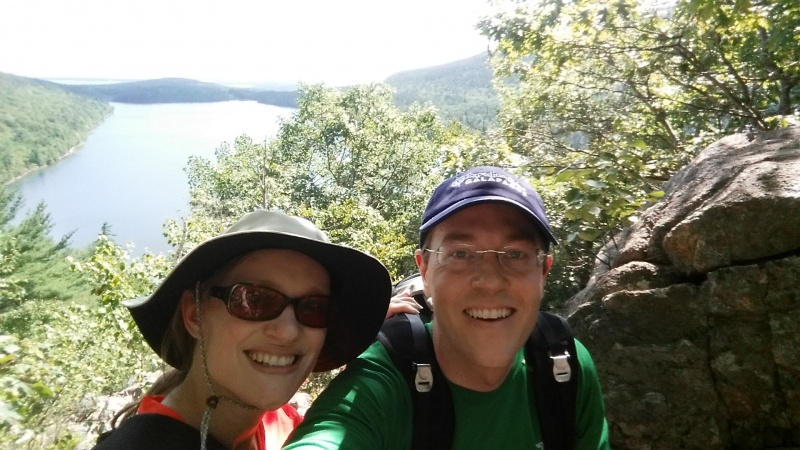
This week we are grateful to catch Dr. George Cheely to share his story. Dr. Cheely is a former Duke medicine resident and now faculty. He tells about his different roles in hospital medicine and as the “Medical Director of Care Redesign” — these keep him connected as a clinician-educator and as an expert in medical systems at the interface of the electronic health record.
How long have you been at Duke?
This academic year marks my seventh at Duke. I came for residency and am in my fourth year on faculty in GIM this year.
What are your responsibilities within the division? What does a typical day for you look like?
I work as a hospitalist and as the Medical Director for Care Redesign. A typical day is a toughie, because my days can be pretty different.
If I’m rounding on a nonteaching service, I’ll arrive around 7a to check labs and vitals, see 12-14 patients into the early afternoon, squeeze in an hour or two of meetings, then work on notes. On teaching, I’ll arrive around the same time and check in with the SAR then start seeing patients and meet with the team later in the morning for teaching rounds. I’ll keep seeing patients, attend meetings, and write notes through the day but will try to see any new admissions with the team in the late afternoon.
If I’m not rounding, I have to keep a flexible schedule to make meetings work — I was triple-booked at 6:30a on Tuesdays for part of this year. I might be updating the leadership team at Duke Raleigh, then hurrying back to DUH to check in with the team leads about the progress of their project, then checking in with the Care Redesign Program team.
I also interview for the Residency program and, recently, began interviewing for the School of Medicine. For those who haven’t learned about our new MMI interview process in the SOM, it’s an innovative approach to avoid interviewer bias and select for people who work well in teams.
Could you tell us more about your roles?
As the Medical Director for Care Redesign, I partner with medical and nursing leaders to oversee design and implementation of improvements in patient care delivery. We identify patient populations and leaders in those clinical areas, bring teams together, provide them with data, a project plan based on QI principles, meeting management support, and access to our expert Maestro provider builders. We’ve worked with more than 500 physicians, nurses, pharmacists, and other clinicians across 28 patient populations spanning inpatient, outpatient, medical, and surgical areas.
We’ve shared our lessons learned at the Brookings Institute and with CMS to inform the structure of their Bundled Payment program.
We’ve also worked with our associate CMIO to develop a process to hardwire care delivery improvements into Maestro — everything from Best Practice Advisors to guide medication selection in Pediatric Cardiology to revamped Summary Views to improve rounding efficiency across all DUHS ICUs. We will have two students from the MMCi program in a practicum course this year to help us examine what components of our informatics approach have had the greatest impact on patient care.
What’s it like to be a hospitalist?
As a hospitalist on Duke GenMed, it’s been a privilege to join the ranks of the faculty members who taught me. I like the mix of teaching and non-teaching time — working with our stellar housestaff and teaching them about our systems of care, brings me a lot of satisfaction. Practicing general medicine in an acutely ill population keeps me sharp, thinking, and learning. Because we work 7- or 14-day blocks, we rely closely on each other for good handovers, and we tend to be more available to help trainees around the house with questions on sick patients. Caring for patients with a wide variety of medical conditions and consulting on surgical patients has also been helpful for my administrative role.
How did you get into internal medicine?
I came to residency considering a couple subspecialties but found that I liked the generalist approach to practice and to decision making. I also really liked the hospitalist groups during rotations at DUH and DRH. Staying general has also helped me to keep credibility as a physician caring for many different types of medical problems
How has your subject area changed (or where you see future changes)?
As I’ve learned more about project development and execution, I’ve learned a lot about the cost associated with care delivery. I’ve worked closely with Finance to better understand our cost accounting structure to help medical leaders make decisions to use resources efficiently without impacting patient outcomes. Nationally, we’re more focused on value than ever before, but I think that concept will become more complicated as payers develop a wider variety of alternative payment models.
What passions or hobbies do you have outside of the division?
My wife and I are pretty serious food and outdoor enthusiasts. Our picture is from a recent trip to Acadia National Park—splendid views and delicious lobster to boot!
Have you recently read any books, articles, blog posts or other material that would be of interest to the division?
Many of us are interested in coming up with new ideas to solve problems. Often, asking the right question is a critical first step. In the quest to find new ways to ask questions, I came across a post by Tina Seelig, a professor at the Standford School for Design, who describes the power of reframing a problem. http://www.fastcodesign.com/1672354/how-reframing-a-problem-unlocks-innovation